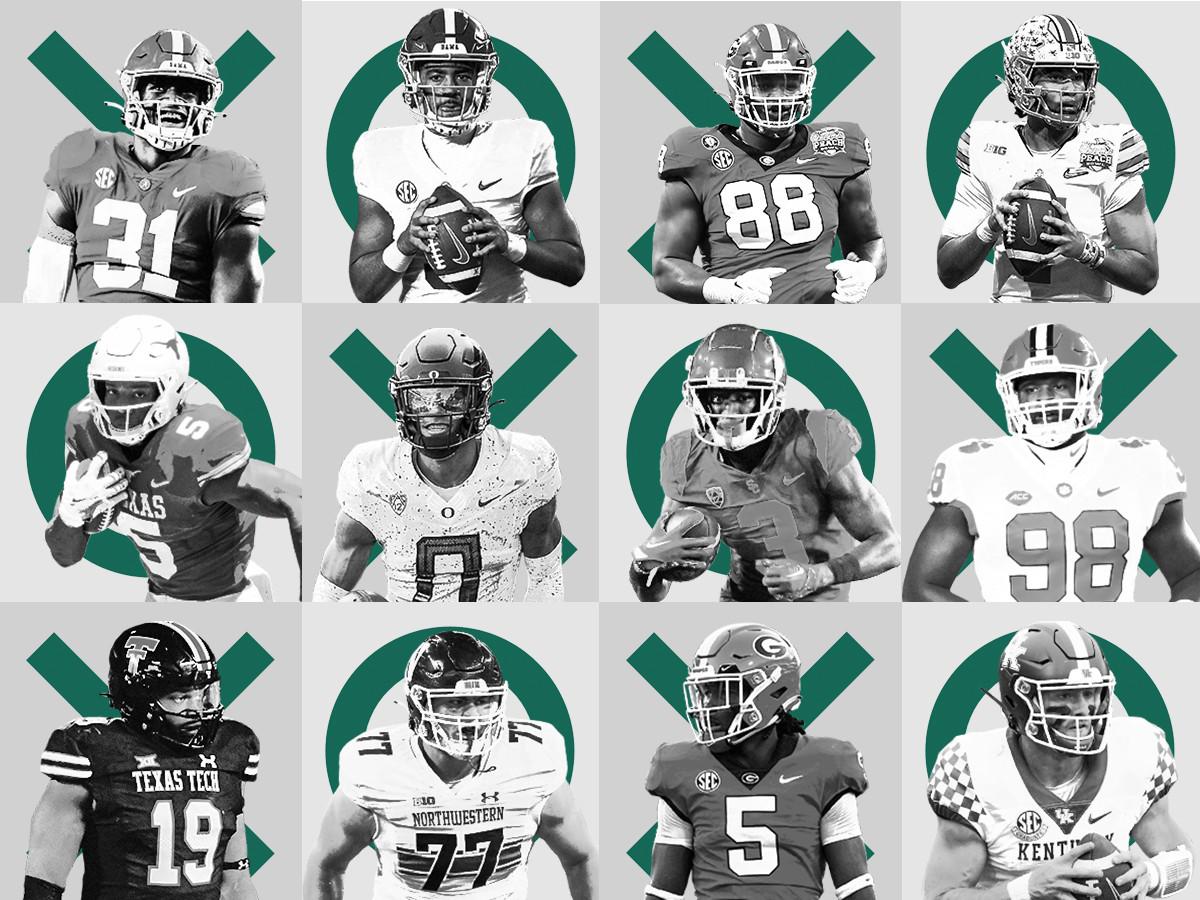
After spending the entire 2022-23 season ranking NFL quarterbacks, you didn’t think I would let draft season pass without putting this year’s prospects through the same wringer, did you? Going off the system I used to judge NFL passers each week last year, I’ve ranked the top five QB prospects in the 2023 class based on my evaluation of their film.
For the uninitiated, I grade quarterbacks in six categories—accuracy, arm talent, decision-making, pocket presence, creativity, and pre-snap process—and those scores are then combined to come up with a weighted overall total that determines the order of the rankings.
Every NFL draft ends up being about the quarterbacks, so let’s dig into the strengths and weaknesses of the top incoming passers and evaluate how those could determine the order they’re taken this week.
1. Anthony Richardson, Florida
Accuracy: 68
Arm Strength: 93
Decision-Making: 65
Pocket Presence: 70
Creativity: 80
Pre-Snap: 60
Overall: 72.9
I don’t get the skepticism surrounding Richardson. I understand why teams might be wary of a one-year starter with spotty production, and we’ve seen plenty of players (at all positions) who do well at the combine only to bust once it’s time to play actual football. But there’s more to Richardson than his blazing 40-yard dash time (4.4 seconds, which ranks in the 98th percentile for quarterbacks) and his powerful arm. You just have to watch the tape to see it.
When I first turned on Richardson’s film, I expected to see a raw passer with little idea of how to work the pocket or make his way through a progression. That was hardly the case. Richardson may be a tad inaccurate—though I think those issues are overblown based on his misleading 54 percent completion rate—but he knows how to play the position. He stands tall in the pocket, uses his eyes to move defenders out of throwing lanes, and throws with anticipation. You don’t typically see raw quarterbacks with those tools in their bags.
Richardson’s been referred to as a project who may require a year or two of seasoning before he can step onto the field; but if he can handle the rigorous pre-snap work required of all NFL QBs, the soon-to-be 21-year-old should be ready to play right away. And while he’s not quite Cam Newton as a runner, he can be the focal point of a successful run game. That will make it easier for a team to get him on the field early while he catches up to the NFL game’s speed.
Biggest Strength: Arm Talent
In terms of raw power, Richardson will enter the league with a top-five arm. The dude can sling it over 60 yards through the air with little effort, and he doesn’t lose any velocity when throwing from a crowded pocket. He’ll need to change speeds more often to be successful at the next level, but there’s nothing on tape to suggest that will be a major problem. It’s not that he can’t throw with touch—it’s more so that he doesn’t always know when to do it. That will change as he gains experience.
Biggest Weakness: Pre-Snap
This is probably the biggest question mark for every quarterback prospect entering the league. But of the top four in this class, Richardson has the most ground to make up. Not only will he have to learn how to call plays and manage a huddle, but he’ll also have to do a better job of adjusting once defenses change looks after the snap. That gave him some issues at Florida.
2. Bryce Young, Alabama
Accuracy: 72
Arm Strength: 73
Decision-Making: 72
Pocket Presence: 68
Creativity: 83
Pre-Snap: 70
Overall: 72.7
If football wasn’t a sport dominated by big, strong athletes, I’d be a lot higher on Young. It’s not just the fact that Young would be tied for the shortest QB ever taken in the top five that scares me. Nor is it his wafer-thin frame. It’s those two things combined with how he plays the position.
He’s the type of quarterback who seeks out danger. If there isn’t a play to be made from the pocket—or if he’s just having a hard time seeing the field—Young doesn’t hesitate to hold onto the ball to try to make something happen. Which gives big, scary defenders more time to line up a hit. And when Young does take off to run, he likes to seek out contact. He said in an April interview that he’ll adjust his game to protect himself in the NFL. But what happens in the heat of the moment when those playmaking instincts kick in? I’m just worried he might have a little too much dog in him.
If not for the injury concerns, Young may have challenged Richardson for the top spot in these rankings. He’s a sharp processor and a highly creative passer, which has earned him plenty of comparisons to NBA point guards—most notably Steph Curry. But that’s a big stretch: Curry is the best shooter to ever grace the court, and Young does not have a standout skill that will allow him to dominate in a similar fashion. He’s got an OK arm and decent speed for the position but no real elite traits outside of his creativity—and creativity takes you only so far.
I wouldn’t be surprised if Young turned into a fringe Pro Bowler. But I would be shocked if he developed into a truly elite quarterback—and that’s what you’re looking for in a top-five pick.
Biggest Strength: Creativity
My comp for Young is a 5-foot-10 Joe Burrow. Both guys are unrelenting playmakers who make up for any physical shortcomings with a preternatural feel for the game. But due to his height, Young is even more reliant on his creativity than the 6-foot-4 Burrow.
Biggest Weakness: Pocket Presence
Young’s comfort in the pocket is actually kind of impressive. But, like Russell Wilson, Young is most dangerous in chaotic situations. Unlike Wilson, he doesn’t have the bulky frame to absorb the contact those plays may invite.
3. C.J. Stroud, Ohio State
Accuracy: 74
Arm Strength: 83
Decision-Making: 69
Pocket Presence: 68
Creativity: 70
Pre-Snap: 63
Overall: 72.5
Stroud has been widely viewed as the safest quarterback prospect in the class. He has the requisite size for the position, a good arm, and just enough athleticism. The two-year starter was productive at Ohio State and got better over the course of his collegiate career. But outside of the impressive out-of-structure creativity he displayed during a critical game against Georgia early this year, he didn’t shoulder much of the playmaking burden in the loaded Buckeyes offense—which has some evaluators questioning his ceiling. There are no such questions about his floor.
Still, Stroud might be the prospect who forces us to adjust our views on what makes a QB prospect “safe.” For all of his solid traits, he doesn’t do anything exceptionally well. Stroud’s accuracy is his primary selling point, but nobody will confuse him with Drew Brees. Plus, throwing to a seemingly endless supply of NFL receivers gave him a margin for error that may have warped our perception of how accurate he really is. In today’s NFL, accuracy alone isn’t enough to propel a quarterback into stardom.
The aforementioned Georgia game complicates Stroud’s evaluation. In a losing effort, Stroud put the Ohio State offense on his back and made a handful of plays that wouldn’t be out of place in a Patrick Mahomes highlight reel. It was the missing piece evaluators were looking for in Stroud’s game. But—and this is a very significant but—it was only one game. That begs the question: Why didn’t he do it more often? The most charitable answer is that he never really had to, thanks to the talent advantage Ohio State enjoyed in almost every game it played. But I wouldn’t be confident enough in that theory to use a top-10 pick on him.
Biggest Strength: Accuracy
I don’t want to make it seem like Stroud was throwing to wide-open receivers on every play. Ryan Day’s scheme often asked him to make throws well outside of the numbers, and Stroud almost always put the ball in a catchable spot—then his NFL-bound receiving corps took care of the rest.
Biggest Weakness: Pocket Presence
Maybe I’m being too harsh here, but if Stroud is going to make it as a top pocket passer, this needs to be an area where he shines. And at this point in his development, he isn’t great at working around pressure, finding space, or making accurate throws. Stroud quickly becomes inaccurate with defenders in his face.
4. Will Levis, Kentucky
Accuracy: 65
Arm Strength: 88
Decision-Making: 62
Pocket Presence: 67
Creativity: 72
Pre-Snap: 70
Overall: 70.3
Look, I get the appeal. Levis is a big, strong kid with an arm that has inspired a handful of viral videos this draft season. He has two years of experience in a pro-style system borrowed from Sean McVay’s “wide zone” offense, and by all accounts, he’s a tremendous leader. But then there’s the whole being good at playing quarterback thing, and that’s one box Levis has yet to check.
Levis was a decent player his junior year before regressing during his final season in Lexington. But there are some valid explanations for his poor play. Levis played through foot, shoulder, and finger injuries. Kentucky lost a lot of talent to the NFL in the previous offseason, so the onus was mostly on Levis to move the football. And he didn’t get much help from offensive coordinator Rich Scangarello, who struggled to replace Liam Coen after Coen left for the Rams offensive coordinator job.
The injuries and personnel changes don’t fully explain Levis’s shortcomings, though: He wasn’t the most accurate quarterback even when healthy, and his playing style—there isn’t a linebacker he’s afraid to take on—contributed to his health issues. Nor do they explain his decision-making, which was puzzling at times.
Levis would be at his best in a play-action-heavy scheme that doesn’t ask him to process much. He’s as talented a thrower as you’ll find, with passable accuracy. And his landing spot will heavily determine the direction of his career.
The 23-year-old has certainly earned his title of the most boom-or-bust prospect in the class.
Biggest Strength: Arm Talent
As strong as Levis’s arm is—refer to this clip if you need convincing—he hasn’t quite figured out how to harness all that power. If/when he learns how to change speeds and throw with touch, he’ll have one of the three or four best arms in the game.
Biggest Weakness: Decision-Making
I’ll just say I wasn’t totally shocked that a person who puts mayo in their coffee and eats unpeeled bananas doesn’t always make sound decisions on the football field.
5. Hendon Hooker, Tennessee
Accuracy: 64
Arm Strength: 75
Decision-Making: 60
Pocket Presence: 65
Creativity: 70
Pre-Snap: 60
Overall: 65.5
Hooker has been a late riser in the draft process and is even getting some first-round buzz despite missing the combine and Tennessee’s pro day because he was recovering from a December surgery to repair a torn ACL. But even if I was willing to look past all of that—plus the fact that he’s only a year younger than Lamar Jackson—I still wouldn’t consider him a first-round prospect. He’s inaccurate, he doesn’t have a lot of arm strength, he played in an offense that doesn’t translate to the next level, and—while he’s certainly athletic—he’s not very mobile in the pocket. And, oh yeah, he’s 25 with a torn ACL!
As you can probably tell, I’m not buying the recent hype, and I’d be shocked if Hooker does end up going in the first round. Either his agent is working their ass off to create this buzz, or teams drafting at the bottom of the round are attempting to stir up a trade market. Those are the only explanations I can rationalize after watching his tape.
Biggest Strength: Arm Talent
When everything is right around him, Hooker can unload a beautiful deep ball, and that talent helped power Tennessee’s prolific offense last season. But that will rarely be the case in the NFL, and without a clean platform, Hooker’s arm is average at best.
Biggest Weakness: Have I mentioned that he’s 25 and still recovering from a torn ACL?




